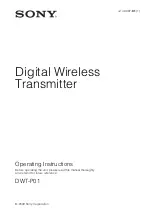
secondary and fall into the category of conveniences or interface capabilities (such as digital or
optical outputs).
A good preamplifier should sound natural, with no sign of edginess or excessive noise. Vacuum
tube preamplifiers sound warm, yet wonderfully airy and transparent. Do not expect a vacuum
tube preamplifier to be as quiet as a solid-state preamp, as electron emissions from tubes tend to
convey more “thermal” noise than transistors. Tube preamplifier noise is far less of an issue with
the SF-24V than with conventional ribbon microphones because the SF-24V’s high output will
override the noise. Transformer coupled preamplifier designs tend to sound punchy and full
bodied and offer the added benefit of true electronic isolation. This greatly enhances their ability
to interface with other equipment with minimal noise or hum. There are many excellent
preamplifiers on the market today.
Choose a preamplifier that fits your budget and offers good performance, but remember that you
get what you pay for. If you have the opportunity to audition one or more preamplifiers before
you buy one, do so. Microphones and preamplifiers work together as a team and some are just
better matches than others. The SF-24V is capable of substantial output signal, especially when
used for high SPL applications like drum overheads. It will not overload or produce distortion up
to its SPL handling capacity of 130 dB SPL. In actuality, the SF-24V’s ribbons would stretch
well before the electronics would reach an overload condition. Due to the high output potential
of the SF-24V, it is recommended that the microphone preamplifier you pair it with have a
switchable pad to prevent the possibility of overloading the preamplifier’s input stage electronics.
Some preamplifiers are more thoughtfully designed than others, with a suitable pad that is placed
before the preamp’s active electronics, not incorporated into a “feedback loop” as is sometimes
found. The latter design could still produce distortion due to overloading even if the pad were
used. Although this is rarely an issue, we felt that it was important to cover the subject. In
conclusion, preamplifier coloration is optional and a matter of personal taste. Some people love
the effect of coloration while others strive for absolute transparency.
Stereo Microphones and Ground Loops
Some preamplifiers are prone to developing ground loops when used in conjunction with stereo
microphones such as the SF-24V. Ground loops can develop in the preamplifier with any stereo
microphone regardless of type (i.e. condenser, dynamic, ribbon) or brand. A ground loop
manifests itself as unwanted buzz or hum at 60 Hz and/or harmonics of 60 Hz.
The condition is brought on when the left and right transducer elements are plugged into two
inputs of a stereo or multi-channel preamplifier. The two male, three-pin XLR connectors of a
stereo microphone's cable (or power supply in the case of the SF-24V) usually share Pin-1 as
common, so they are grounded to each other at the microphone or power supply. If the grounding
scheme within the preamplifier is poorly designed, or the distances to internal ground are too
great, a ground loop develops.
11
Содержание SF-24V
Страница 21: ...Polar Pattern Frequency Response 21 ...
Страница 22: ...Wiring Diagram 22 ...









































